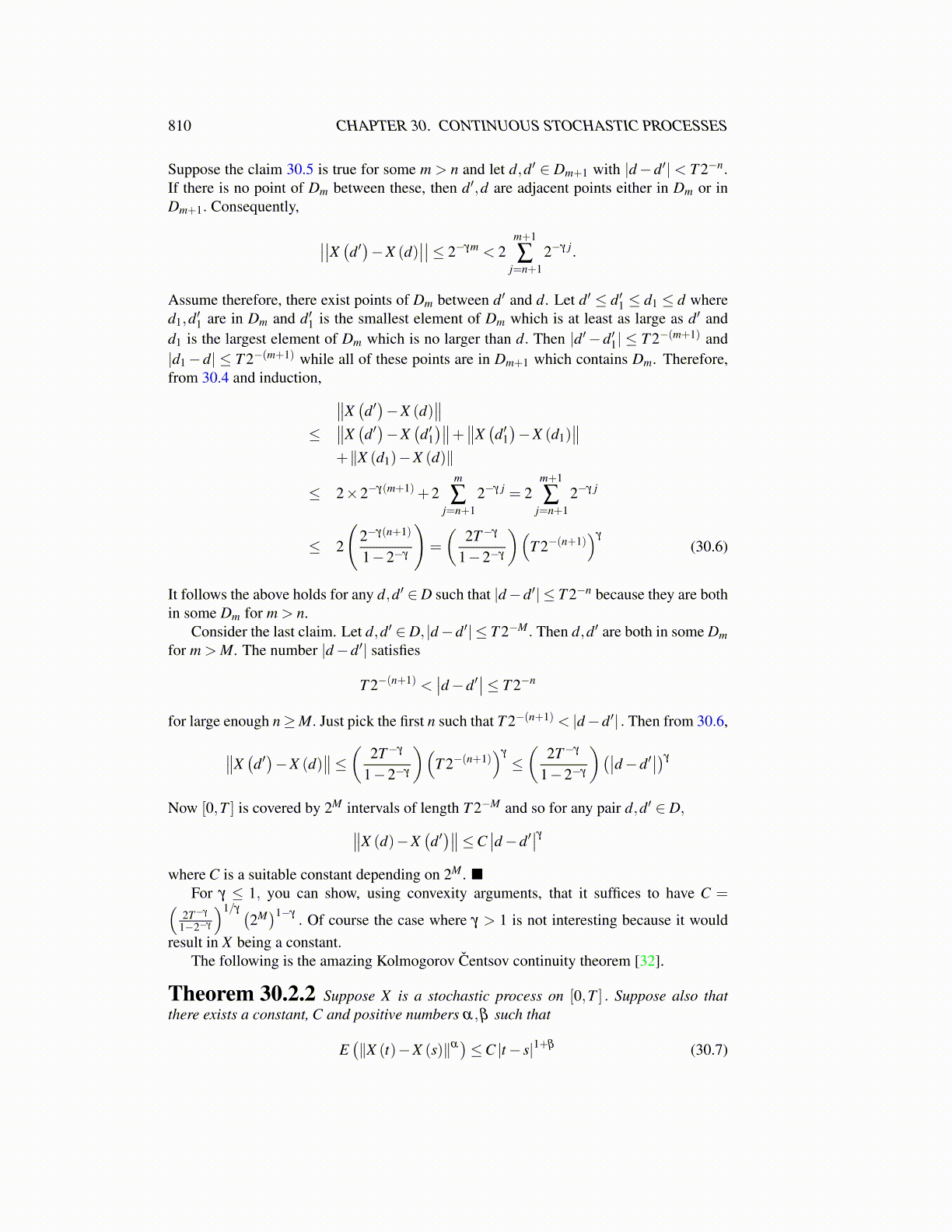
810 CHAPTER 30. CONTINUOUS STOCHASTIC PROCESSES
Suppose the claim 30.5 is true for some m > n and let d,d′ ∈ Dm+1 with |d−d′| < T 2−n.If there is no point of Dm between these, then d′,d are adjacent points either in Dm or inDm+1. Consequently,
∣∣∣∣X (d′)−X (d)∣∣∣∣≤ 2−γm < 2
m+1
∑j=n+1
2−γ j.
Assume therefore, there exist points of Dm between d′ and d. Let d′ ≤ d′1 ≤ d1 ≤ d whered1,d′1 are in Dm and d′1 is the smallest element of Dm which is at least as large as d′ andd1 is the largest element of Dm which is no larger than d. Then |d′−d′1| ≤ T 2−(m+1) and|d1−d| ≤ T 2−(m+1) while all of these points are in Dm+1 which contains Dm. Therefore,from 30.4 and induction, ∥∥X
(d′)−X (d)
∥∥≤
∥∥X(d′)−X
(d′1)∥∥+∥∥X
(d′1)−X (d1)
∥∥+∥X (d1)−X (d)∥
≤ 2×2−γ(m+1)+2m
∑j=n+1
2−γ j = 2m+1
∑j=n+1
2−γ j
≤ 2
(2−γ(n+1)
1−2−γ
)=
(2T−γ
1−2−γ
)(T 2−(n+1)
)γ
(30.6)
It follows the above holds for any d,d′ ∈D such that |d−d′| ≤ T 2−n because they are bothin some Dm for m > n.
Consider the last claim. Let d,d′ ∈D, |d−d′| ≤ T 2−M. Then d,d′ are both in some Dmfor m > M. The number |d−d′| satisfies
T 2−(n+1) <∣∣d−d′
∣∣≤ T 2−n
for large enough n≥M. Just pick the first n such that T 2−(n+1) < |d−d′| . Then from 30.6,
∥∥X(d′)−X (d)
∥∥≤ ( 2T−γ
1−2−γ
)(T 2−(n+1)
)γ
≤(
2T−γ
1−2−γ
)(∣∣d−d′∣∣)γ
Now [0,T ] is covered by 2M intervals of length T 2−M and so for any pair d,d′ ∈ D,∥∥X (d)−X(d′)∥∥≤C
∣∣d−d′∣∣γ
where C is a suitable constant depending on 2M . ■For γ ≤ 1, you can show, using convexity arguments, that it suffices to have C =(
2T−γ
1−2−γ
)1/γ (2M)1−γ
. Of course the case where γ > 1 is not interesting because it wouldresult in X being a constant.
The following is the amazing Kolmogorov Čentsov continuity theorem [32].
Theorem 30.2.2 Suppose X is a stochastic process on [0,T ] . Suppose also thatthere exists a constant, C and positive numbers α,β such that
E(∥X (t)−X (s)∥α
)≤C |t− s|1+β (30.7)